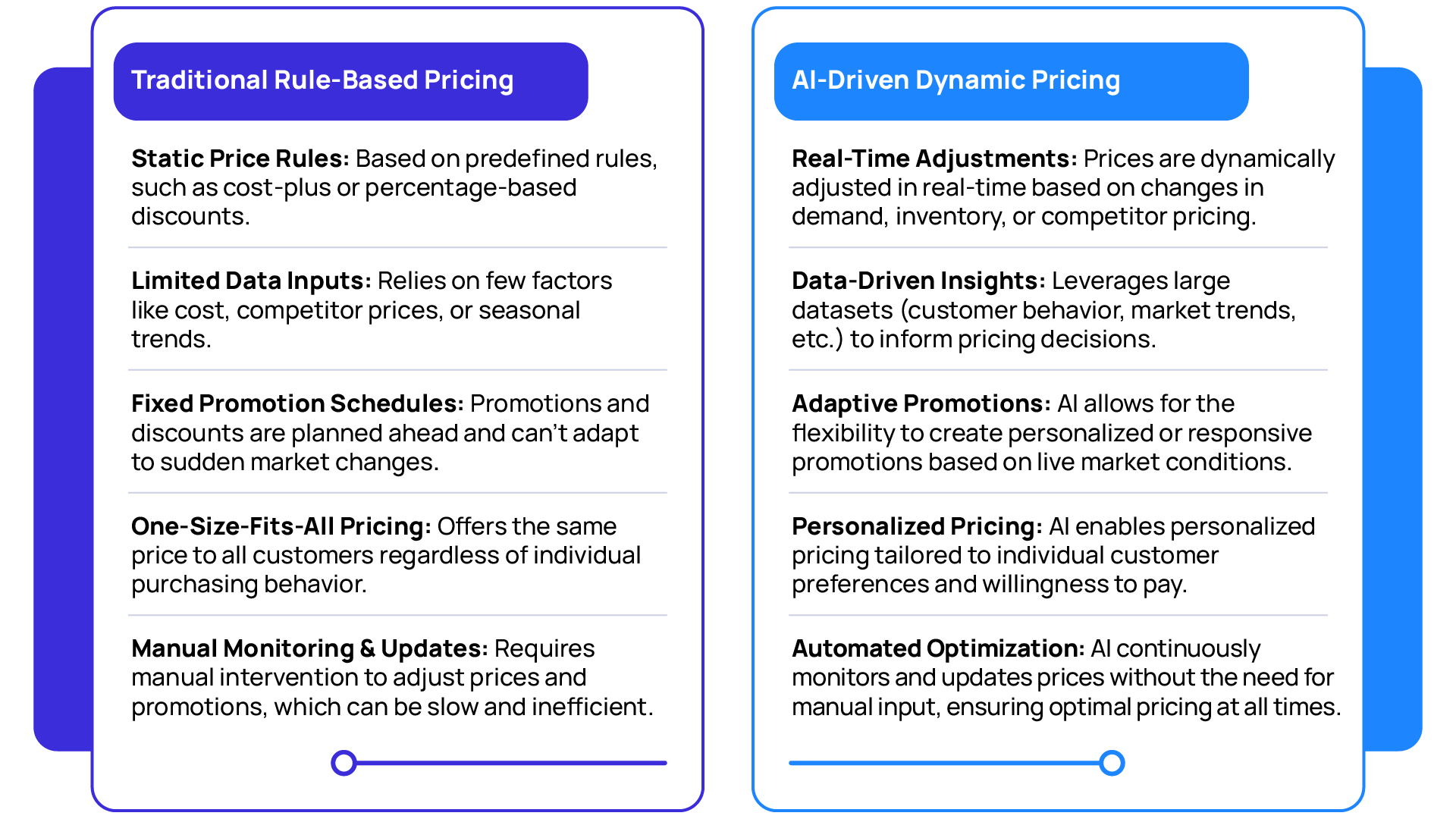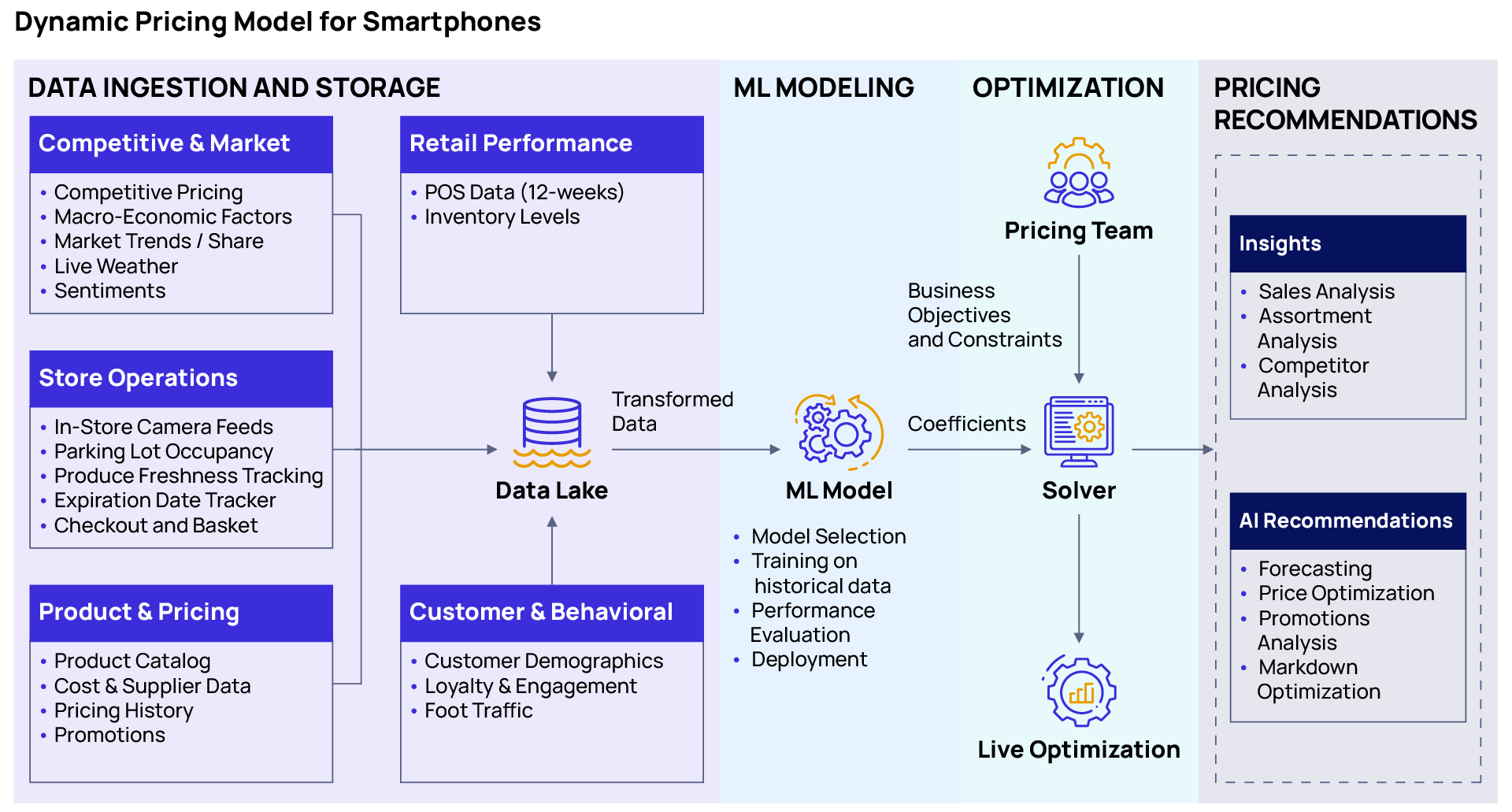Retail is no longer the predictable industry it once was. Ongoing geopolitical tensions, inflationary pressures, supply chain challenges, and the aftershocks of global health crises have created an unpredictable economic climate that demands agility and precision. According to a report from EY and World Retail Congress, retail business models need to adapt to drive growth. In this volatile environment, retailers must re-examine their pricing strategies, as effective pricing is a crucial factor in staying ahead of the competition while remaining profitable and aligned with customer expectations.
So, how do retailers set the right prices?
Pricing has always been a delicate balancing act. The need for pricing accuracy is not new; but the complexity of achieving it has significantly increased because the current environment introduces a multitude of dynamic factors that complicate the process. If you consider the electronics sector, think about pricing a smartphone. What do you think retailers today need to account for?
- Supplier pricing, which fluctuates due to changes in component costs (like microchips or displays) and directly impacts margins.
- Supply chain disruptions, such as semiconductor shortages, that drive costs higher.
- Competitor moves, like new product launches or aggressive discount strategies that demand rapid response.
- Seasonal demand spikes, around Black Friday or holiday sales, which significantly influence pricing strategies.
- Product lifecycle considerations, where older models require markdowns as newer versions hit the shelves.
- Regional factors, from customer demographics to economic conditions. Because pricing in a tech-savvy urban store might differ from a rural one.
With so many variables at play, it’s no surprise that traditional pricing methods like manual adjustments or static rules are struggling to keep up.
Traditionally, retailers would often set prices based on predefined rules, such as cost-plus pricing or fixed discounts. But in today’s dynamic market, this approach is becoming increasingly inadequate.
So, where does the answer lie?
Let’s consider the rapid pace of change in consumer preferences and competitor actions. To navigate the complexities of modern retail, businesses must adopt more agile and data-driven pricing strategies. This means leveraging real-time data and advanced analytical tools to respond to market fluctuations, ensuring that pricing strategies are aligned with both customer expectations and business objectives.
The Case for AI-Powered Dynamic Pricing in Retail
What if there were a way to adapt prices in real time based on live market conditions, customer behavior, and competitor actions? AI-powered dynamic pricing makes this possible! As consumer behaviors evolve, this modern approach to pricing, deeply rooted in the historical practices of barter and negotiation, is gaining attention. It offers retailers the precision and agility needed to thrive in today’s dynamic retail environment.
How Does Dynamic Pricing in Retail Help?
Simply put, dynamic pricing allows retailers to:
- Maximize revenue by aligning prices with consumer demand, capturing maximum value from every sale.
- Optimize inventory by accelerating the movement of slow-selling items and avoiding overstock.
- Delight customers with personalized, responsive pricing experiences that feel fair and relevant.
Let’s break it down to compare this approach to the traditional methods:

Dynamic Pricing in Action: Real-World Applications
AI-powered dynamic pricing is already transforming businesses across industries. Amazon Marketplace, for example, uses it to compete in the e-commerce industry. Using real-time data, Amazon not only matches or beats competitors’ prices but tailors its own to customers’ preferences, browsing histories, and purchase behaviors, according to Harvard Business School. Likewise, in fashion retail, brands adjust prices seasonally, increasing them during peak periods (like holiday shopping) and slashing them during slower times to clear inventory. Dynamic pricing helps here by optimizing revenue and balancing inventory levels in real-time. On the other hand, convenience stores use dynamic pricing to tackle perishables. Fresh produce nearing expiration is discounted to encourage sales, while fresher stock is priced higher. This reduces waste, maximizes revenue, and provides customers with affordable choices.

Building an AI-Powered Dynamic Pricing Model: A Smartphone Example
Let’s understand how a dynamic pricing model for smartphones might work.
Data collection
Creating a dynamic pricing model for smartphones begins with collecting diverse data, including competitor pricing, customer behavior, inventory levels, and market trends. For instance, prices for popular models like the iPhone and Samsung Galaxy can be gathered using web scraping tools such as Scrapy or BeautifulSoup. Additionally, insights into demand trends and seasonality can be obtained from platforms like Google Trends or NielsenIQ. This comprehensive data collection is crucial for informing pricing strategies that respond effectively to market dynamics.
Customer behavior
Customer purchase behavior, such as preferences for specific brands, storage capacities, and features, can be gathered through e-commerce browsing data, CRM systems, and insights from loyalty programs. This information is invaluable as it helps the model identify which product attributes drive demand across various customer segments.
Machine learning models
All this data is consolidated into a central data lake, which feeds into machine learning models like regression, decision trees, or neural networks. These models are trained to predict demand and price sensitivity, learning how different inputs, such as competitor actions, marketing campaigns, and seasonal trends, can impact sales. The output of these machine learning models includes coefficients like price elasticity, which quantify how demand responds to changes in pricing.
Optimization engine
These coefficients, along with business objectives (e.g., maximizing profit or market share) and constraints (e.g., price thresholds and margin targets), are then passed into an optimization engine. The optimizer defines the objective function, and a mathematical solver calculates the optimal price for each smartphone SKU (Stock Keeping Unit) while considering real-world constraints.
Continuous learning
Once deployed, the model continuously learns from real-time sales data and competitor updates. For instance, if a competitor launches a new phone, the system can automatically adjust prices based on historical trends of similar releases.
Seamless integration
Finally, optimized prices are computed and made available for the pricing team to review and approve. Once approved, these prices can be seamlessly updated in the retailer’s ERP system and pushed to downstream systems such as Point-of-Sale (PoS) and Electronic Shelf Labels (ESL). This capability enables retailers to respond swiftly to changing market conditions with accurate, data-driven pricing decisions—boosting smartphone sales, maintaining competitiveness, and maximizing profitability in a fast-moving category.

The Role of Generative AI in Dynamic Pricing
Generative AI adds a powerful new dimension to dynamic pricing strategies. It’s not just about crunching numbers anymore, but about tapping into some unconventional data sources that can really enhance pricing strategies. For example, imagine using satellite images to figure out how many people live in a certain area. This kind of insight can help retailers gauge potential demand for smartphones in those neighborhoods.
But that’s just the tip of the iceberg. Generative AI can also analyze things like parking lot data or even footage from store cameras. This means it can track how many customers are coming in, how they move around the store, and how crowded it gets. All of this information gives retailers a clearer picture of customer behavior and helps them spot shifts in demand.
What’s even more exciting is that Generative AI can pick up on local events, like a concert or a big sale at a nearby mall—that might temporarily boost interest in certain products. By weaving these insights into their pricing models, retailers can adjust prices on the fly based on what’s happening right in their community.
In short, this smarter approach to pricing allows retailers to make more informed decisions that can boost profits while keeping customers happy. It’s all about being quick on your feet and responsive to the ever-changing market!

To sum up, AI-powered dynamic pricing is revolutionizing the retail landscape by enabling retailers to set optimal prices in real-time, adapting to both market conditions and consumer behavior. According to BCG, retailers that have made this transition have increased gross profit by 5% to 10% while also sustainably increasing revenue and improving customer value perception. With machine learning models continuously refining their predictions and Generative AI adding new layers of insight through unconventional data sources, businesses can now make more informed, granular pricing decisions. This not only boosts profitability but also enhances customer satisfaction through tailored pricing strategies. As retail continues to evolve in an increasingly competitive environment, embracing AI-driven pricing solutions will be essential for staying ahead of the curve and maximizing long-term success.
Why AI-Powered Dynamic Pricing Is the Future
At Hexaware, we believe that dynamic pricing isn’t just a tool—it’s a vital strategy for retailers navigating today’s rapidly evolving market. With AI and machine learning models continuously refining pricing based on real-time data, retailers can swiftly adapt to shifts in demand, competition, and market conditions.
Generative AI enhances this value by integrating unique data sources, such as foot traffic and local trends, to optimize pricing decisions. This leads to smarter, faster choices that boost revenue, enhance customer satisfaction, and provide retailers with a sustainable competitive edge. In an unpredictable retail landscape, dynamic pricing is no longer optional; it has become essential for long-term success.
How Hexaware Can Help
Hexaware’s AI-driven dynamic pricing solution, powered by RapidPricer, equips retailers like you to make real-time, data-backed pricing decisions that align with your business goals. Our solution combines demand signals, customer behavior insights, competitor pricing, and inventory data to deliver you with optimal price recommendations—all seamlessly integrated into your existing systems.
Whether you want to:
- Improve margins
- Enhance operational efficiency, or
- Stay competitive in a fast-moving market
We’re here to help you get started. Ready to explore how dynamic pricing in retail can transform your business? Let’s connect for a demo, a pricing workshop, or a tailored proof of concept.
Take control of your pricing strategy. Let Hexaware help you unlock new levels of profitability and customer satisfaction today!



















